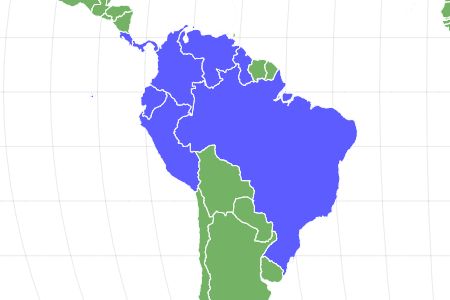Lives in groups of up to 500 individuals!
Advertisement
Squirrel Monkey Scientific Classification
- Kingdom
- Animalia
- Phylum
- Chordata
- Class
- Mammalia
- Order
- Primates
- Family
- Cebidae
- Genus
- Saimiri
- Scientific Name
- Saimiri
Read our Complete Guide to Classification of Animals.
Squirrel Monkey Conservation Status
Squirrel Monkey Facts
- Prey
- Fruit, Insects, Flowers
- Name Of Young
- Infant
- Group Behavior
- Troop
- Fun Fact
- Lives in groups of up to 500 individuals!
- Estimated Population Size
- Not Known
- Biggest Threat
- Habitat loss
- Most Distinctive Feature
- Longer tail than body used for balance
- Other Name(s)
- Deaths Head Monkey
- Gestation Period
- 170 days
- Habitat
- Dense, tropical jungle close to a stream
- Predators
- Birds of Prey, Snakes, Humans
- Diet
- Omnivore
- Average Litter Size
- 1
- Lifestyle
- Diurnal
- Common Name
- Squirrel Monkey
- Number Of Species
- 5
- Location
- Central and South America
- Slogan
- Lives in groups of up to 500 individuals!
- Group
- Mammal
Squirrel Monkey Physical Characteristics
- Color
- Grey
- Yellow
- Black
- Olive
- Skin Type
- Fur
- Top Speed
- 22 mph
- Lifespan
- 15 - 20 years
- Weight
- 0.75kg -1.1k g (1.7lbs - 2.4lbs)
- Height
- 25cm - 36cm (9.8in - 14in)
- Age of Sexual Maturity
- 3 - 5 years
- Age of Weaning
- 4 months
View all of the Squirrel Monkey images!
Classification And Evolution
The Squirrel Monkey is the smallest species of New World monkey that is native to the forests and tropical jungles of Central and South America. Measuring only .84 ounces from the top of the head to the base of their tail, these mini monkeys are more than double their size when you include their long tail. Unlike many other species of small monkeys, the tail of the squirrel monkey is not prehensile and therefore cannot be utilized for gripping branches. Rather, their long tail is used to help the squirrel monkey balance when climbing on high branches.
As a new world monkey, the squirrel monkey is a descendant of an ancient African primate that is said to have migrated to South America on a raft constructed of vegetation. Due to a lack of fossil evidence, the exact origin of the early primates is not fully known. It is believed that new-world monkeys began to appear in the middle of the Cenozoic epoch, during the Paleogene era, from 66 million to 23 million years ago, and they most likely split from the old-world monkeys sometime around 40 million years ago.
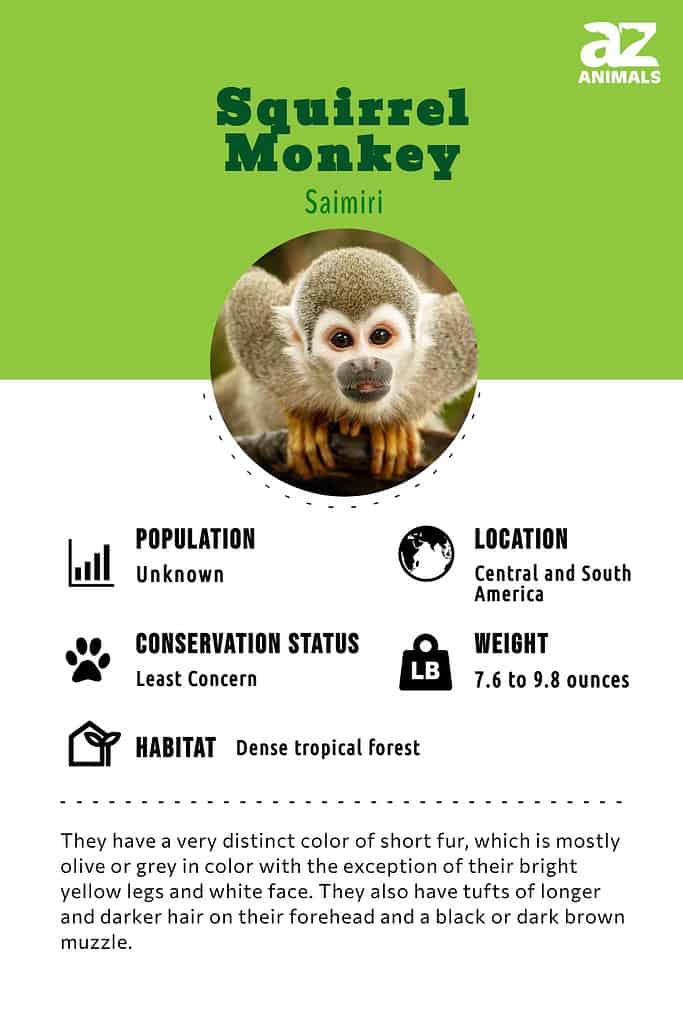
Types Of
Squirrel monkeys are divided into two groups, which contain a total of five species that are found in varying locations. While all the squirrel monkey species do resemble each other in appearance, they all have slight variations in fur color and reside in different regions.
There is the Saimiri sciureus group, which contains the Common Squirrel Monkey, the Central American Squirrel Monkey, and the Bare-eared Squirrel Monkey, and the Saimiri boliviensis group, which contains the Black Squirrel Monkey and the Black-Capped Squirrel Monkey. Each monkey species contains its own subspecies as well.
Anatomy And Appearance
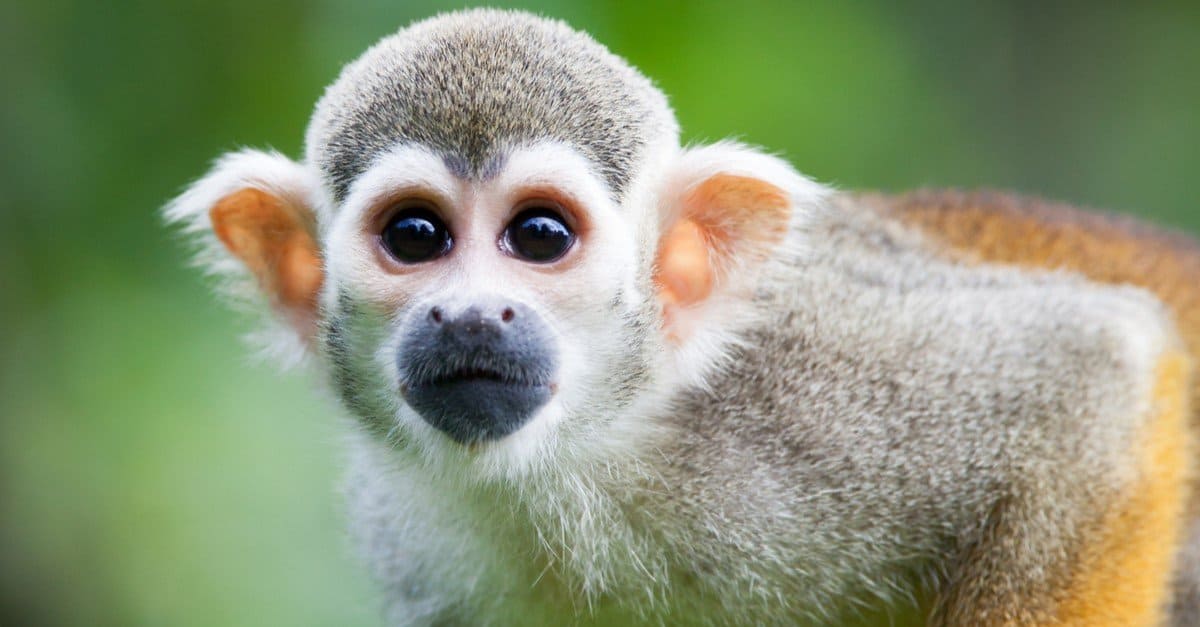
This primate is well adapted to spending a majority of time up in the trees.
©l i g h t p o e t/Shutterstock.com
Although both male and female Squirrel Monkeys appear to be almost identical in size and appearance, males actually tend to be slightly larger and heavier than their female counterparts. Squirrel Monkeys have a very distinct color of short fur, which is mostly olive or grey in color with the exception of their bright yellow legs and white face. The Squirrel Monkey also has a tuft of longer and darker hair on its forehead and a black or dark brown muzzle.
These little primates spend a great deal of time high in the trees and are very well adapted to doing so with incredibly dexterous fingers that are not only great for gripping onto branches, but also come in very useful when opening fruits and holding onto prey. The long tail of the Squirrel Monkey is longer than its body and has a quite slim ending with a dark, bushy tip.
Distribution And Habitat
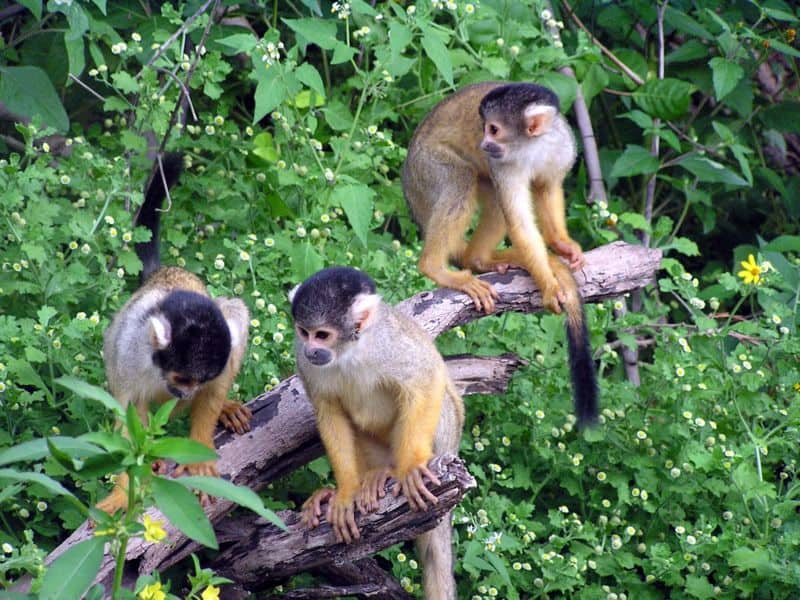
Squirrel Monkeys can be found in Central and South America.
©Lindadevolder assumed (based on copyright claims), CC BY-SA 3.0, via Wikimedia Commons – Original / License
The five different species of squirrel monkeys are found throughout Central and South America, extending as far as the upper Amazon Basin. Squirrel monkeys tend to prefer regions of dense, tropical forests that are close to a stream or other flowing water source which is thought to be for safety. Most active during the day, this mammal can be found at the middle level of the forest canopy and will rarely venture towards the top as they are in danger of being caught by birds, or down to the ground in fear of other predators. Squirrel Monkeys can, however, be found in a variety of forest types and have even been known to inhabit areas that have been cleared for agriculture. They are under threat though from habitat loss that is primarily in the form of deforestation for agriculture and growing Human settlements.
Behavior And Lifestyle
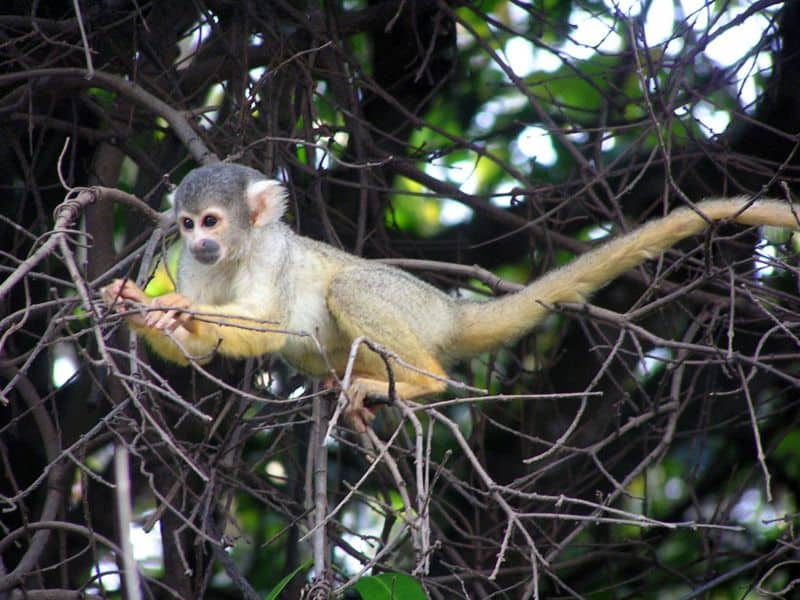
The Squirrel Monkey is a very sociable animal that moves noisily in the trees.
©Linda de Volder, CC BY-SA 3.0, via Wikimedia Commons – Original / License
Squirrel monkeys are incredibly sociable animals that move about noisily in the trees in large troops that are usually 40 or 50 animals large but can contain up to 500 individuals. These troops usually contain a number of sub-groups including adult males, pregnant females, females with their young, and groups of young squirrel monkeys. They communicate with one another using a range of different noises with these complex social troops sleeping together at night before breaking up into their sub-groups to feed during the day.
Adept climbers, leaping between branches to travel through the forest, their long tails provide them with excellent balance and aided by their nimble hands and feet, allow Squirrel Monkeys to cover vast areas of the jungle. They are also known to follow other troops at a distance to take advantage of the food left in their path.
Reproduction And Life Cycles
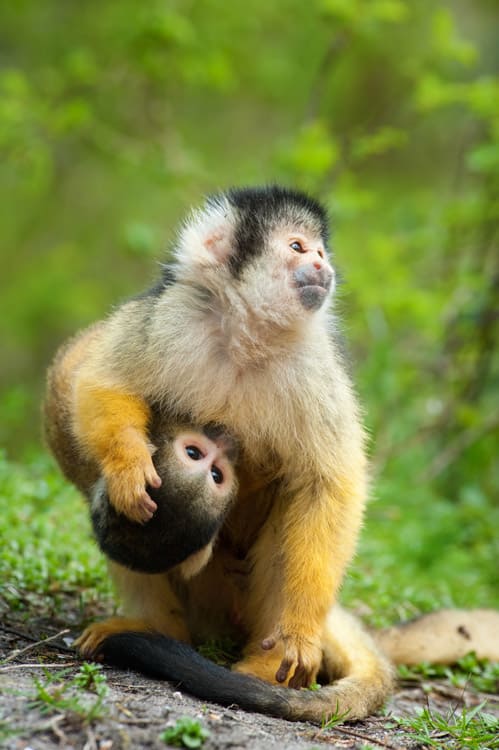
Females have a gestation period that lasts 5 months and will then carry her young on her back.
©Eric Gevaert/Shutterstock.com
At the start of the breeding season, the shoulders of male Squirrel Monkeys broaden and they begin to fight aggressively for their right to mate, with the winner earning mating rights with the most females. Shortly after giving birth, the female Squirrel Monkey will chase away the male who plays no part in raising the single infant and leaves to join his all-male group. Births tend to occur during a short period of time which corresponds with the heaviest annual rainfall between June and August.
After a gestation period that lasts for around five months, the female begins to carry her young on her back from the first day. By the time the infant is two months old, it begins to explore more without its mother and is almost completely independent by the time it is 10 months old. Young females may stay with or close to their mother for some time but males will leave her to join a young all-male group.
Diet And Prey
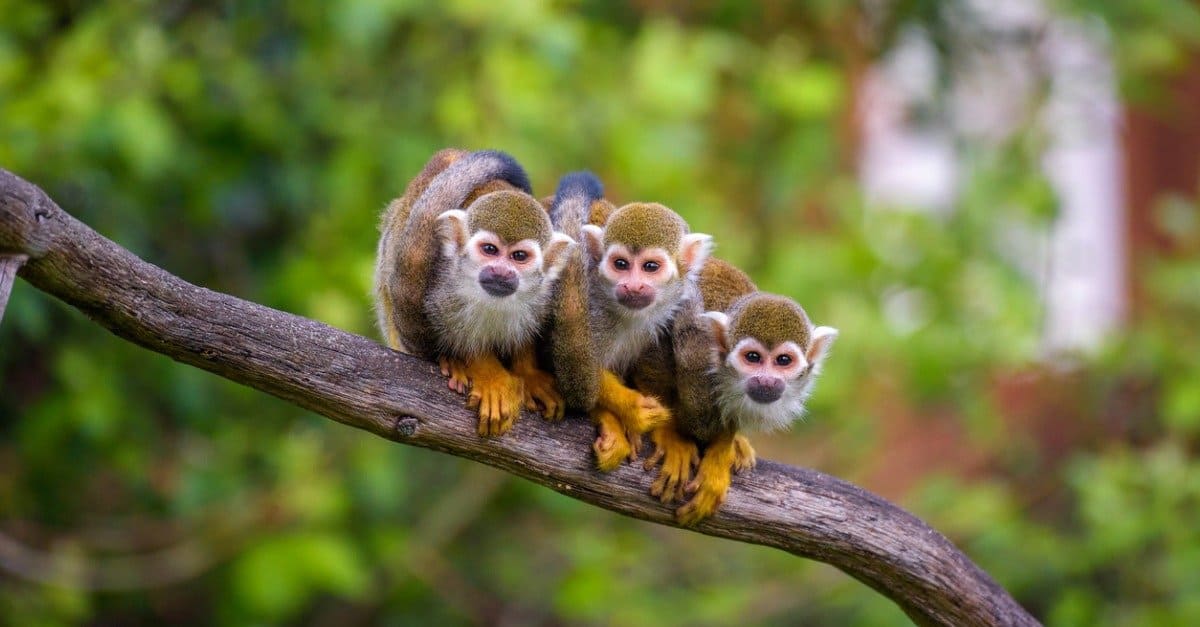
Squirrel monkeys have a varied diet that is made up of insects and fruits.
©iStock.com/miroslav_1
The Squirrel Monkey is an omnivorous animal that eats small animals, plants, and plant matter in order to survive, feeding during the day in their smaller sub-groups. Squirrel Monkeys have a widely varied diet that is primarily comprised of fruits and insects. They are also known to eat flowers, buds, eggs, nuts, lizards, and other small vertebrates that are found amongst the surrounding leaves and branches.
The hands and fingers of the Squirrel Monkey are perfectly designed for holding onto food while either peeling it or eating it, which it does with the use of its small but sharp teeth. However, in areas that have been more affected by deforestation, squirrel monkeys have been known to raid agricultural plantations in search of food.
Predators And Threats
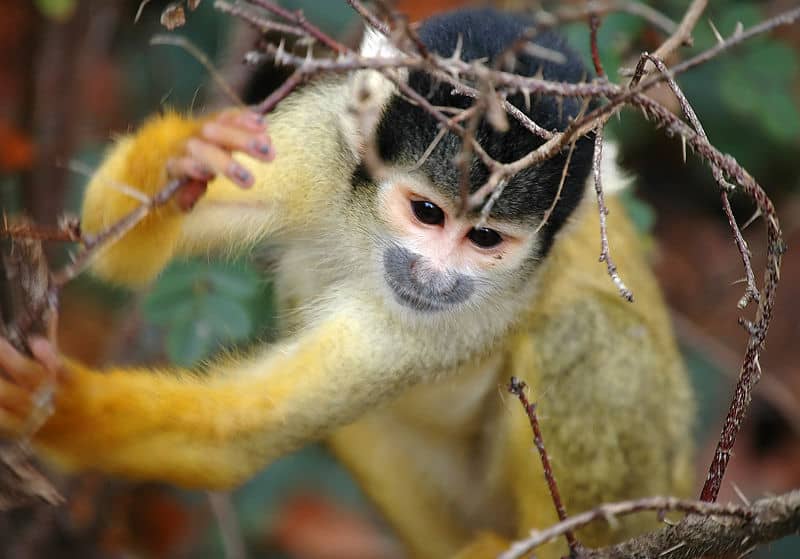
The Squirrel monkey will use a special warning sound to communicate with their troop.
©Marieke Kuijpers from ‘s-Hertogenbosch, Netherlands, CC BY 2.0, via Wikimedia Commons – Original / License
The Squirrel Monkey uses a number of vocal commands to communicate with the rest of the troop including special warning sounds which indicate the presence of a dangerous predator. As one of the smallest species of New World Monkeys, they are preyed upon by a variety of forest animals. Birds of Prey are the biggest threat to squirrel monkeys along with snakes that are able to hunt them in the trees.
Due to the fact that habitat loss has forced Squirrel Monkeys in some areas to eat crops, they are threatened by methods used to try and keep them away. The fact that they inhabit the jungle with enormous troops means that they have also been severely affected by the decrease in the forest as there is not enough food to sustain the whole troop.
Interesting Facts And Features
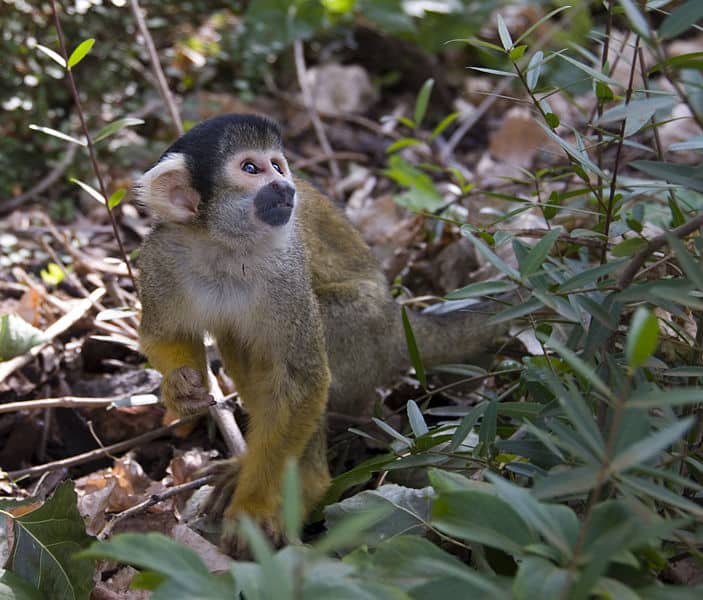
This primate is thought to be one of the smartest primate species.
©Jon Hanson from London, UK, CC BY-SA 2.0, via Wikimedia Commons – Original / License
The Squirrel Monkey is thought to be one of the most intelligent species of primate and is known to have the largest brain-to-body mass ratio of all the monkey species in the world. They have incredibly good eyesight and color vision which means that they are able to spot fruits amongst the dense vegetation with ease. While feeding in really dense foliage, they are known to make a “chuck-chuck” sound to indicate their location to other members of their troop and are also known to spread urine on their hands and feet which enables them to leave a scent trail while moving about in the trees.
Relationship With Humans
Due to the small size and highly intelligent nature of squirrel monkeys, they have been captured and kept as pets in both their native regions and around the world. Although the majority of squirrel monkey pets today are bred from captive animals, the capture of them in the past for the exotic pet trade has had an effect on wild populations, particularly in certain areas. The squirrel monkey is still more threatened by increasing levels of human activity in their native regions, particularly in the form of deforestation for logging and land clearance for agriculture.
Conservation Status
As of today, the squirrel monkey is an animal species that is at a lower risk in its natural environment than a number of other New World Monkey species. However, two out of the five Squirrel Monkey species are listed as Vulnerable by the IUCN and two are listed as being of Least Concern. Population numbers of all five species though are threatened by habitat loss, with their large troops being pushed into smaller and smaller areas of their natural habitat.
View all 293 animals that start with SSquirrel Monkey FAQs (Frequently Asked Questions)
Are Squirrel Monkeys herbivores, carnivores, or omnivores?
Squirrel Monkeys are Omnivores, meaning they eat both plants and other animals.
What Kingdom do Squirrel Monkeys belong to?
Squirrel Monkeys belong to the Kingdom Animalia.
What class do Squirrel Monkeys belong to?
Squirrel Monkeys belong to the class Mammalia.
What phylum to Squirrel Monkeys belong to?
Squirrel Monkeys belong to the phylum Chordata.
What family do Squirrel Monkeys belong to?
Squirrel Monkeys belong to the family Cebidae.
What order do Squirrel Monkeys belong to?
Squirrel Monkeys belong to the order Primates.
What type of covering do Squirrel Monkeys have?
Squirrel Monkeys are covered in Fur.
What genus do Squirrel Monkeys belong to?
Squirrel Monkeys belong to the genus Saimiri.
Where do Squirrel Monkeys live?
Squirrel Monkeys live in Central and South America.
In what type of habitat do Squirrel Monkeys live?
Squirrel Monkeys live in dense, tropical jungles close to streams.
What are some predators of Squirrel Monkeys?
Predators of Squirrel Monkeys include birds of prey, snakes, and humans.
How many babies do Squirrel Monkeys have?
The average number of babies a Squirrel Monkey has is 1.
What is an interesting fact about Squirrel Monkeys?
Squirrel Monkeys live in groups of up to 500 individuals!
What is the scientific name for the Squirrel Monkey?
The scientific name for the Squirrel Monkey is Saimiri.
What is the lifespan of a Squirrel Monkey?
Squirrel Monkeys can live for 15 to 20 years.
How many species of Squirrel Monkey are there?
There are 5 species of Squirrel Monkey.
What is the biggest threat to the Squirrel Monkey?
The biggest threat to the Squirrel Monkey is habitat loss.
What is another name for the Squirrel Monkey?
The Squirrel Monkey is also called the death’s head monkey.
How many Squirrel Monkeys are left in the world?
The population size of the Squirrel Monkey is unknown.
How fast is a Squirrel Monkey?
A Squirrel Monkey can travel at speeds of up to 22 miles per hour.
What are the differences between spider monkeys and squirrel monkeys?
The main differences between a spider monkey and a squirrel monkey are size, the presence of a prehensile tail, and their appearance.
How to say Squirrel Monkey in ...
Thank you for reading! Have some feedback for us? Contact the AZ Animals editorial team.
Sources
- David Burnie, Dorling Kindersley (2011) Animal, The Definitive Visual Guide To The World's Wildlife / Accessed December 16, 2008
- Tom Jackson, Lorenz Books (2007) The World Encyclopedia Of Animals / Accessed December 16, 2008
- David Burnie, Kingfisher (2011) The Kingfisher Animal Encyclopedia / Accessed December 16, 2008
- Richard Mackay, University of California Press (2009) The Atlas Of Endangered Species / Accessed December 16, 2008
- David Burnie, Dorling Kindersley (2008) Illustrated Encyclopedia Of Animals / Accessed December 16, 2008
- Dorling Kindersley (2006) Dorling Kindersley Encyclopedia Of Animals / Accessed December 16, 2008
- David W. Macdonald, Oxford University Press (2010) The Encyclopedia Of Mammals / Accessed December 16, 2008
- Squirrel Monkey Information / Accessed December 16, 2008
- About Squirrel Monkeys / Accessed December 16, 2008

